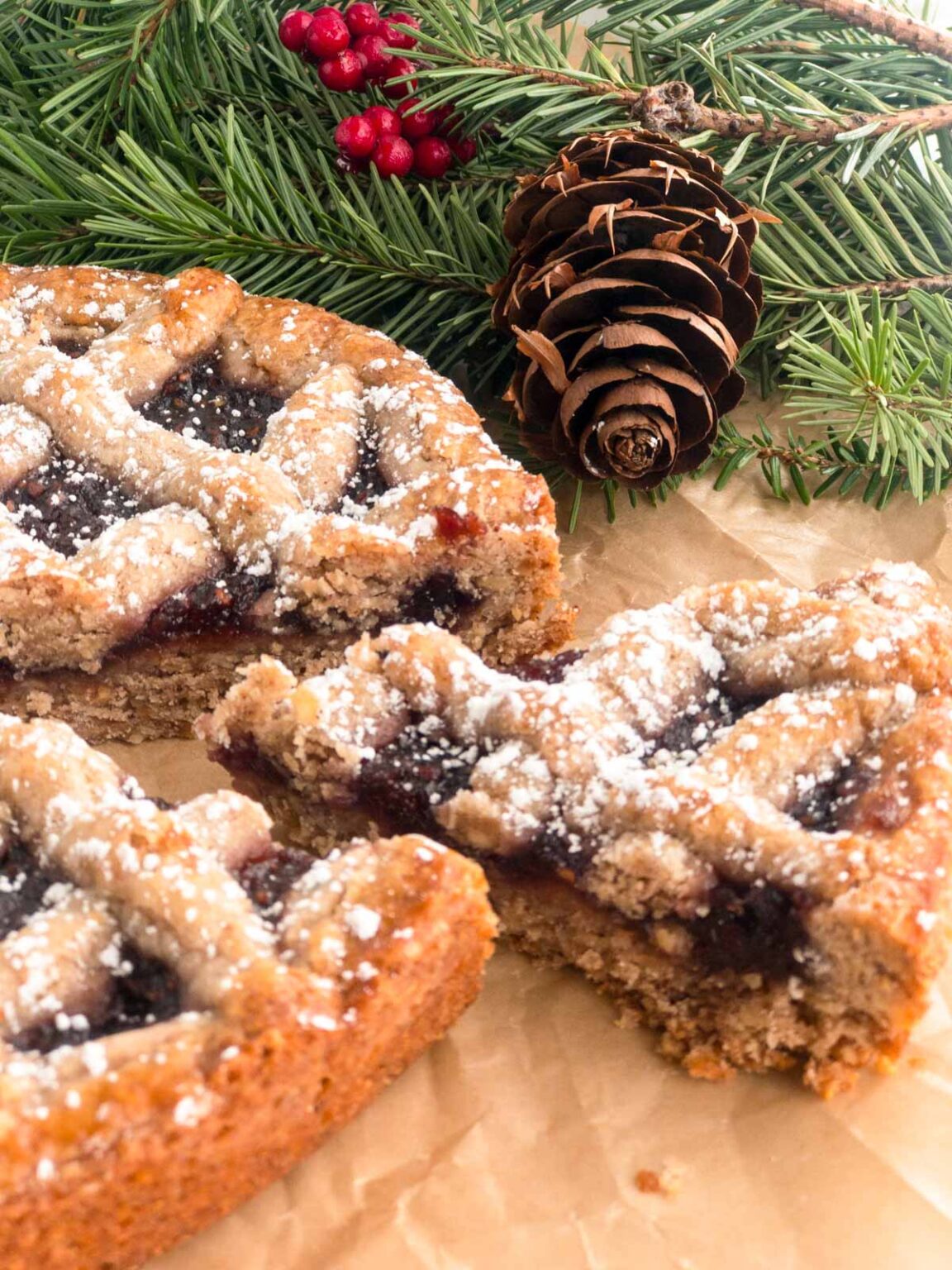German desserts offer a delightful journey into the country’s sweet traditions. From cakes to pastries, these treats showcase the rich flavors and techniques that have been passed down through generations.
You’ll find a mix of simple, homey recipes and more elaborate confections that are perfect for special occasions.
German desserts often feature fresh fruits, nuts, and spices, creating a perfect balance of flavors and textures. Many of these recipes have regional roots, reflecting the diverse culinary landscape across Germany.
Whether you’re craving something light and fruity or rich and chocolatey, German desserts have something to satisfy every sweet tooth. Get ready to explore a world of tasty treats that will transport you to cozy German bakeries and kitchens.
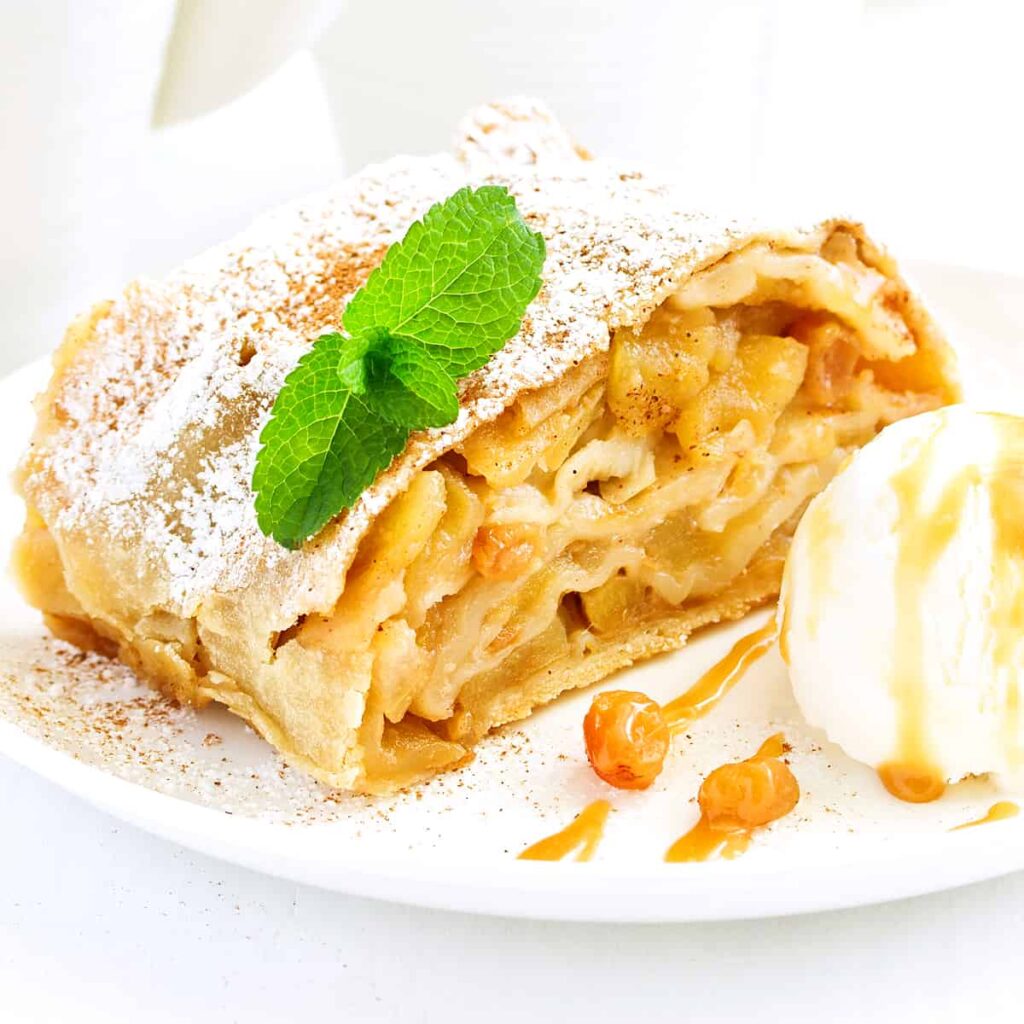
1. Apfelstrudel
Apfelstrudel is a beloved German dessert that will transport you to a cozy bakery in Bavaria. This flaky pastry is filled with sweet, tart apples and warm spices.
To make Apfelstrudel, you’ll need thinly sliced apples, sugar, cinnamon, and raisins.
The dough is rolled out very thin and stretched to create delicate layers.
Once filled, the strudel is rolled up and baked until golden brown. The result is a crispy exterior with a soft, juicy apple filling.
Serve it warm with a dusting of powdered sugar or a scoop of vanilla ice cream for a truly indulgent treat.
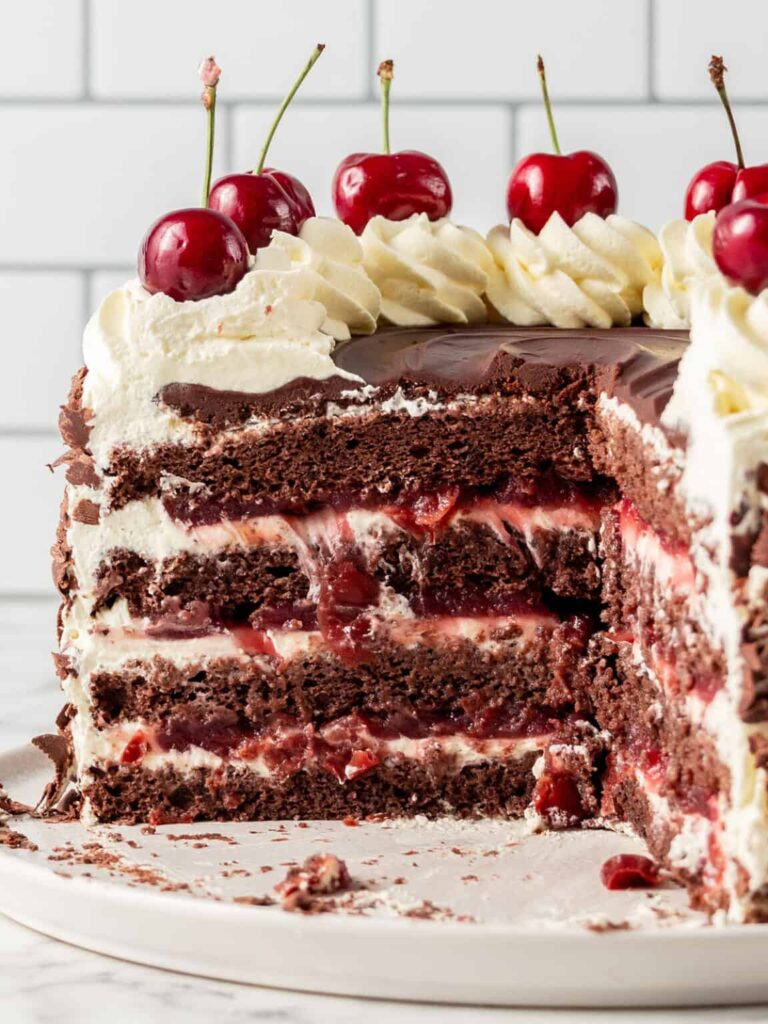
2. Black Forest Cake
Black Forest Cake is a classic German dessert that’s loved worldwide. You’ll find layers of chocolate sponge cake, whipped cream, and cherries in this treat.
To make it, you bake chocolate cake layers and let them cool. Then you soak the layers with cherry juice or kirsch.
Next, you spread whipped cream and cherries between each layer.
The cake gets covered in more whipped cream and decorated with chocolate shavings.
This cake looks impressive and tastes even better. It’s perfect for special occasions or when you want a rich, indulgent dessert.
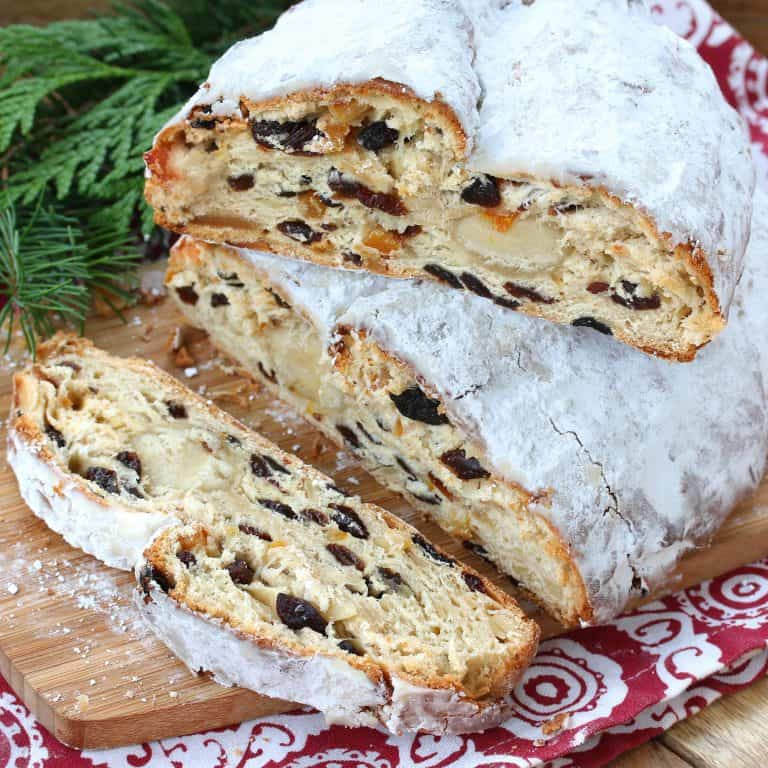
3. Stollen
Stollen is a beloved German Christmas bread. You’ll find this sweet treat in bakeries and homes during the holiday season.
The dense, buttery bread is packed with dried fruits and nuts. It’s often dusted with powdered sugar, giving it a festive look.
Stollen has a rich history dating back centuries. Dresden is famous for its version, called Dresdner Christstollen.
You can enjoy stollen plain or spread with butter. It pairs well with coffee or tea.
Many people like to slice and serve it as a dessert or breakfast item.
Making stollen takes time, but the result is worth it. You can also find pre-made versions in stores during Christmas time.
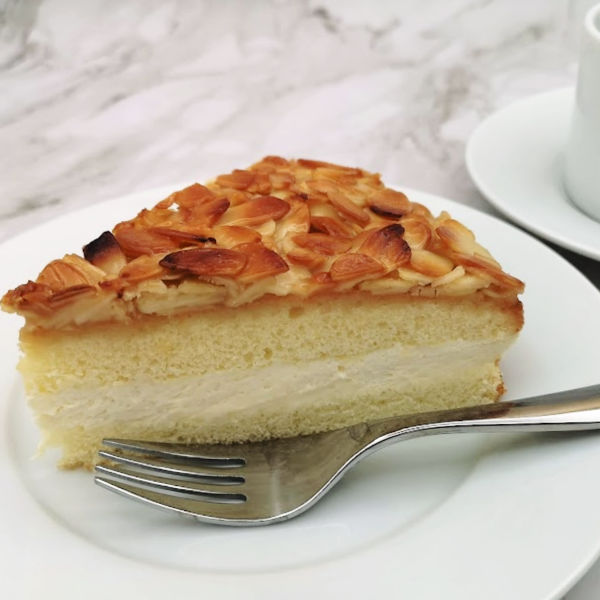
4. Bienenstich (Bee Sting Cake)
Bienenstich, or Bee Sting Cake, is a beloved German dessert that will satisfy your sweet tooth. This treat features a light yeast cake filled with creamy vanilla custard and topped with crunchy honey-glazed almonds.
To make this cake, you’ll start with a soft, airy yeast dough. While it rises, prepare the vanilla custard filling and the signature almond topping. The honey in the topping gives the cake its name, as legend says a bee was attracted to the sweet glaze.
Once baked, you’ll slice the cake in half and spread the custard inside. The result is a delightful mix of textures and flavors – fluffy cake, smooth cream, and crispy nuts.
Enjoy a slice with coffee or as an after-dinner treat.
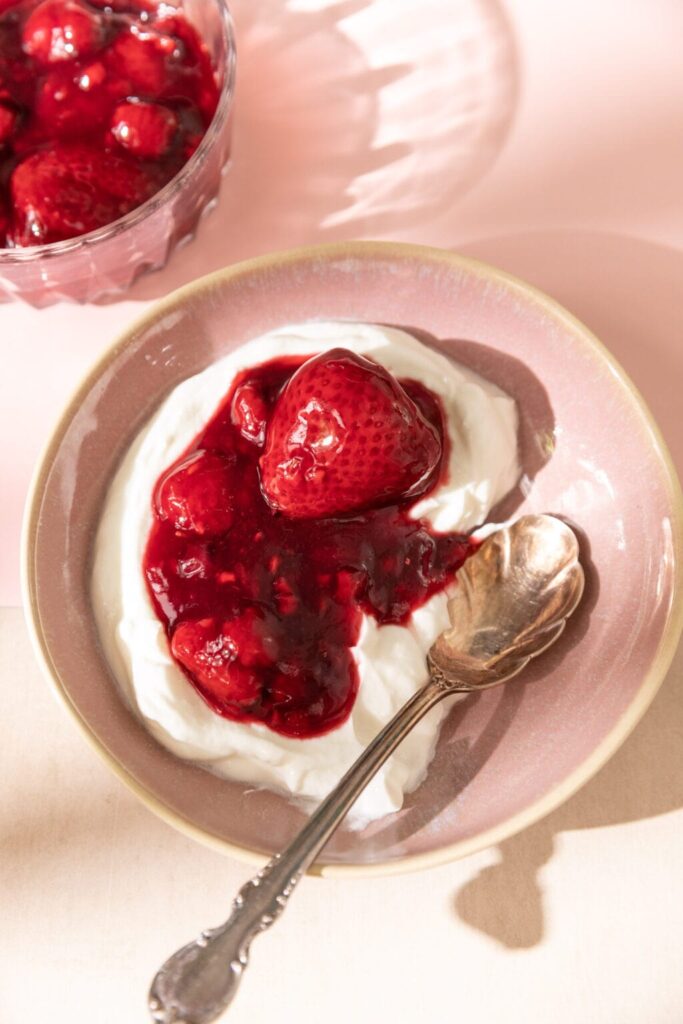
5. Rote Grütze
Rote Grütze is a classic German dessert bursting with summer flavors. This sweet treat features a mix of red berries cooked into a thick pudding.
You’ll often find strawberries, raspberries, and cherries in Rote Grütze. The fruits are simmered with sugar and thickened with cornstarch.
To serve, pour the warm or chilled pudding into bowls. Top it with a generous splash of cold cream or vanilla sauce for a delightful contrast.
Rote Grütze is perfect for warm summer days. You can enjoy it as a light dessert or even as part of your breakfast.
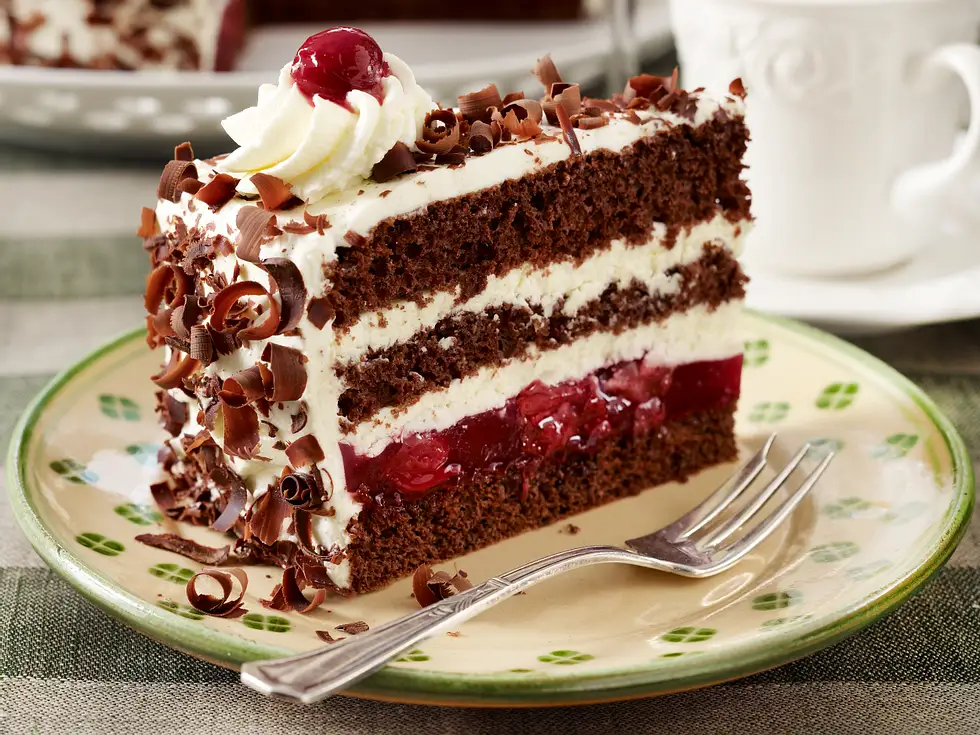
6. Schwarzwälder Kirschtorte
Schwarzwälder Kirschtorte is a classic German dessert you’ll love. This Black Forest cake features layers of chocolate sponge cake, whipped cream, and cherries.
To make it, you’ll bake a chocolate sponge cake and slice it into three layers. Between each layer, you’ll spread whipped cream and add cherries.
The cake is then covered with more whipped cream and decorated with chocolate shavings. For an authentic touch, you can add a splash of Kirsch (cherry brandy) to the filling.
This impressive dessert is perfect for special occasions. You can find it in many German bakeries, but it’s also fun to make at home.
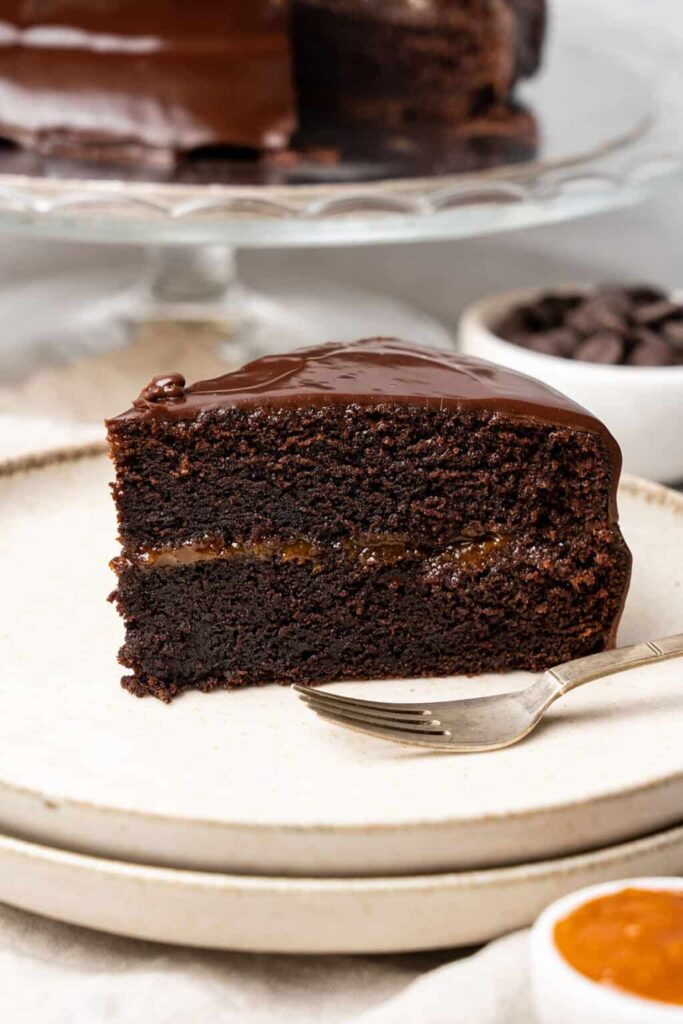
7. Sachertorte
Sachertorte is a famous German chocolate cake that originated in Austria. This rich dessert features layers of chocolate sponge cake with apricot jam filling.
The cake is covered in a smooth chocolate glaze, giving it a elegant appearance. To make Sachertorte, you’ll melt chocolate and mix it with butter, sugar, and egg yolks.
Fold in beaten egg whites and flour to create a light batter. Bake the cake, then slice it horizontally and spread with warm apricot jam. The final touch is pouring a chocolate glaze over the entire cake.
Sachertorte is perfect for special occasions or as an indulgent treat with coffee. You can find simplified recipes that use cake mix as a shortcut while still capturing the classic flavors.
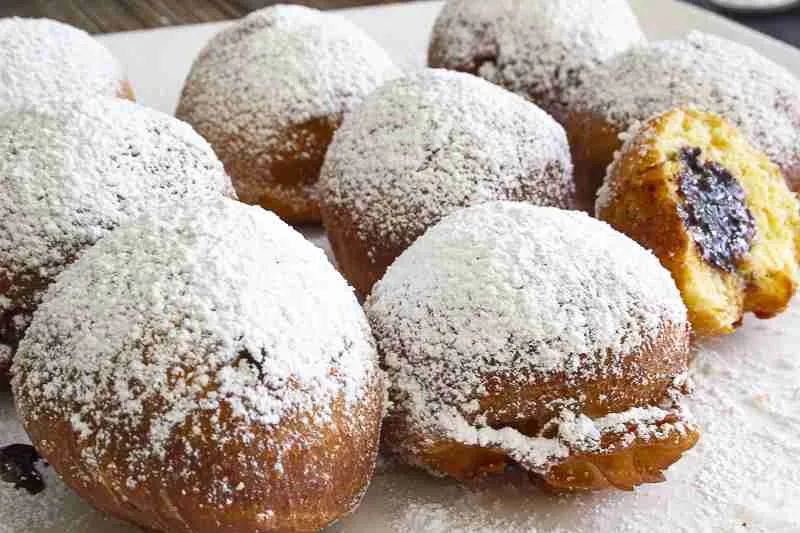
8. Berliner Pfannkuchen
Berliner Pfannkuchen are traditional German doughnuts loved across the country. These sweet treats are made from a rich yeast dough and deep-fried to golden perfection.
Unlike American doughnuts, Berliners don’t have holes. They’re filled with fruit jam after frying. Popular fillings include raspberry, cherry, or plum.
To make Berliners, you’ll need to let the dough rise twice. Then, form it into small balls and fry them in hot oil at about 350°F. Once golden brown, let them cool slightly before filling.
Berliner doughnuts are often dusted with powdered sugar. You can enjoy these delicious pastries any time of day, but they’re especially popular during carnival season.
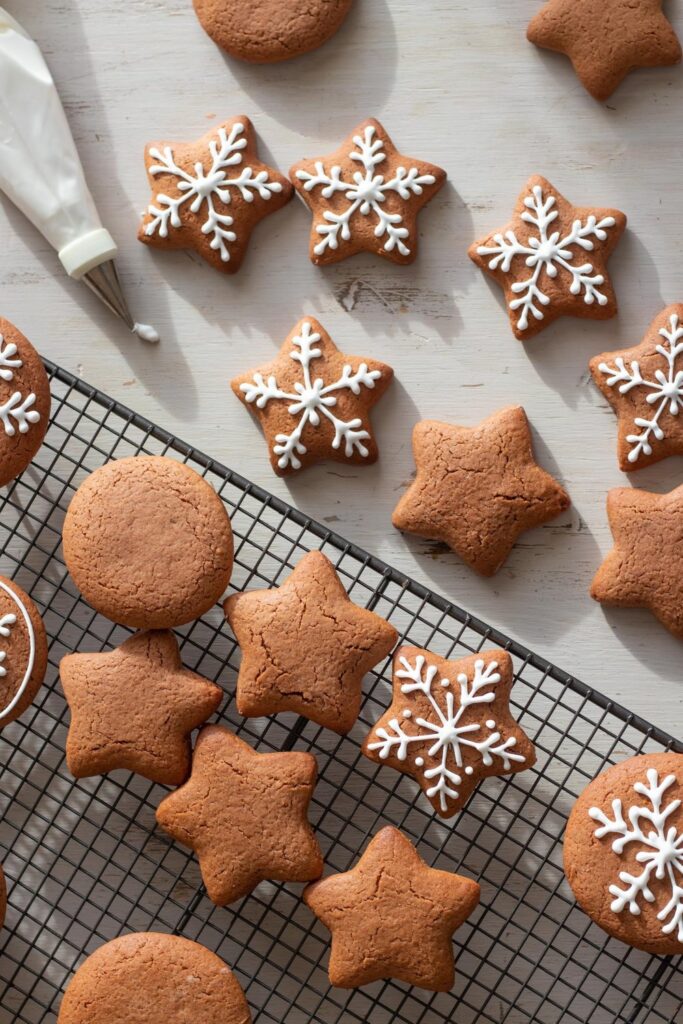
9. Lebkuchen
Lebkuchen are traditional German cookies that bring warmth to the holiday season. These soft, spiced treats have a rich history dating back centuries.
You’ll find lebkuchen filled with nuts, candied citrus peel, and aromatic spices like cinnamon and cloves. The dough often includes honey for sweetness and a chewy texture.
Bakers shape lebkuchen into rounds, hearts, or rectangles. Some varieties have a thin sugar glaze or chocolate coating. Others feature whole almonds pressed into the top for decoration.
You can enjoy lebkuchen plain or use them to make festive gingerbread houses. These cookies stay fresh for weeks, making them perfect for gifting or savoring throughout the winter months.
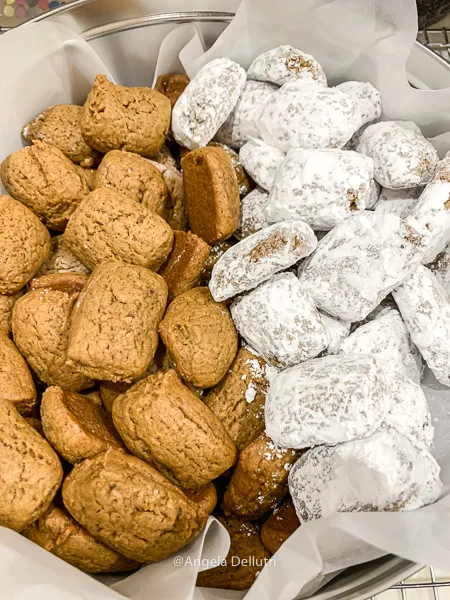
10. Pfeffernüsse
Pfeffernüsse are spicy German cookies popular during Christmas. These small, round treats are packed with flavor from a mix of warm spices.
You’ll taste cinnamon, cloves, nutmeg, and black pepper in these cookies. The name “Pfeffernüsse” means “pepper nuts” in German, referring to their spiciness and shape.
These cookies have a soft, cake-like texture inside. They’re often coated with powdered sugar or a thin glaze on the outside.
You can enjoy Pfeffernüsse with coffee or tea. They make great gifts and are perfect for holiday cookie exchanges.
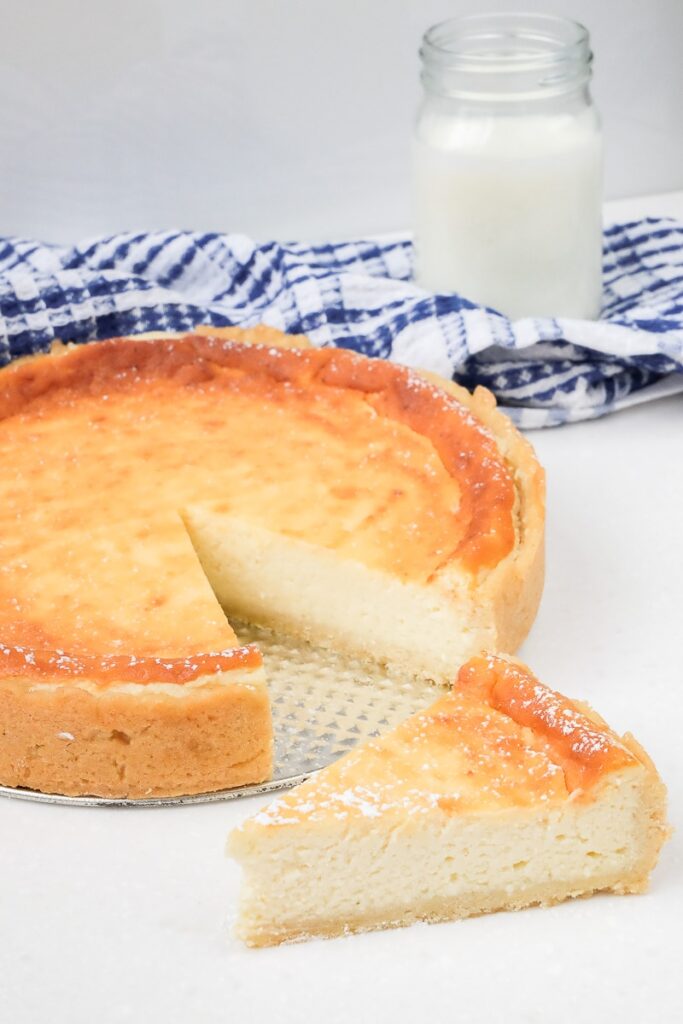
11. Käsekuchen (German Cheesecake)
Käsekuchen is a beloved German dessert that differs from its American counterpart. The star ingredient is quark, a fresh cheese similar to yogurt.
This cheesecake has a lighter texture and tangier flavor than New York-style versions. You’ll find a hint of lemon in most recipes, adding a refreshing twist.
The crust is often made with butter and flour, creating a shortbread-like base. Some bakers add ground nuts for extra flavor and crunch.
To make Käsekuchen, you’ll mix quark with eggs, sugar, and cornstarch. Folding in whipped egg whites helps achieve its signature fluffy texture.
Baked until golden, this cheesecake is best enjoyed slightly warm or at room temperature. It’s a tasty way to experience authentic German baking at home.
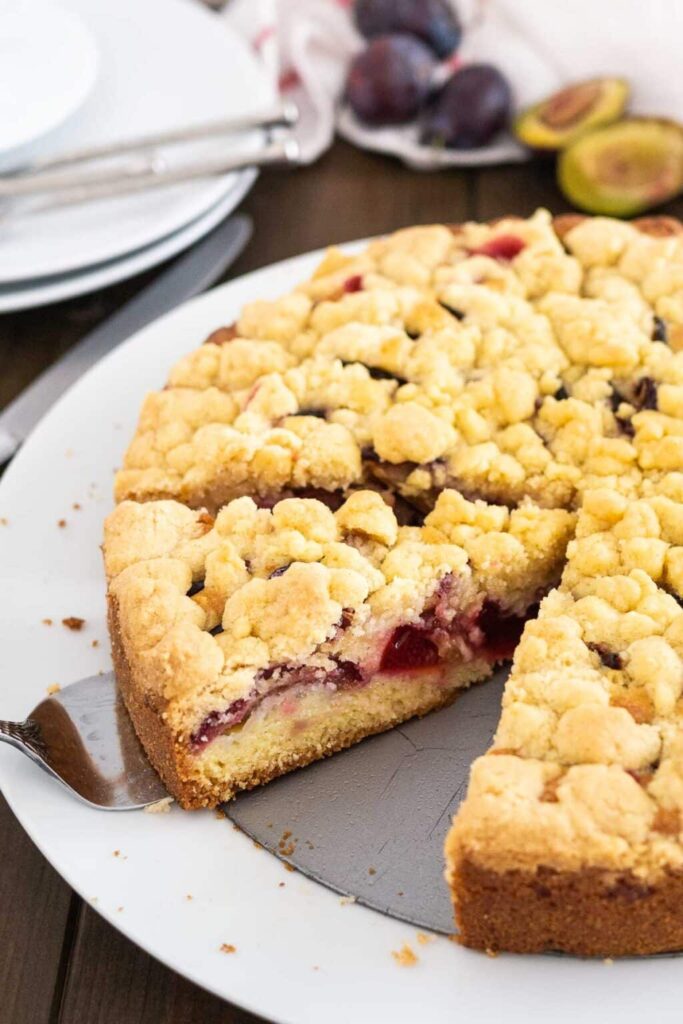
12. Zwetschgenkuchen (Plum Cake)
Zwetschgenkuchen is a beloved German plum cake you’ll want to try. This sweet treat features juicy plums nestled in a soft, yeast-based dough.
You can find different versions across Germany. Some have a streusel topping, while others are simpler. The cake is often made with Italian plums, which are smaller and more oval-shaped than regular plums.
You’ll love how the plums become tender and slightly tart as they bake. The cake itself is not too sweet, making it perfect for dessert or even breakfast.
Try serving it with a dollop of whipped cream or a scoop of vanilla ice cream for extra indulgence.
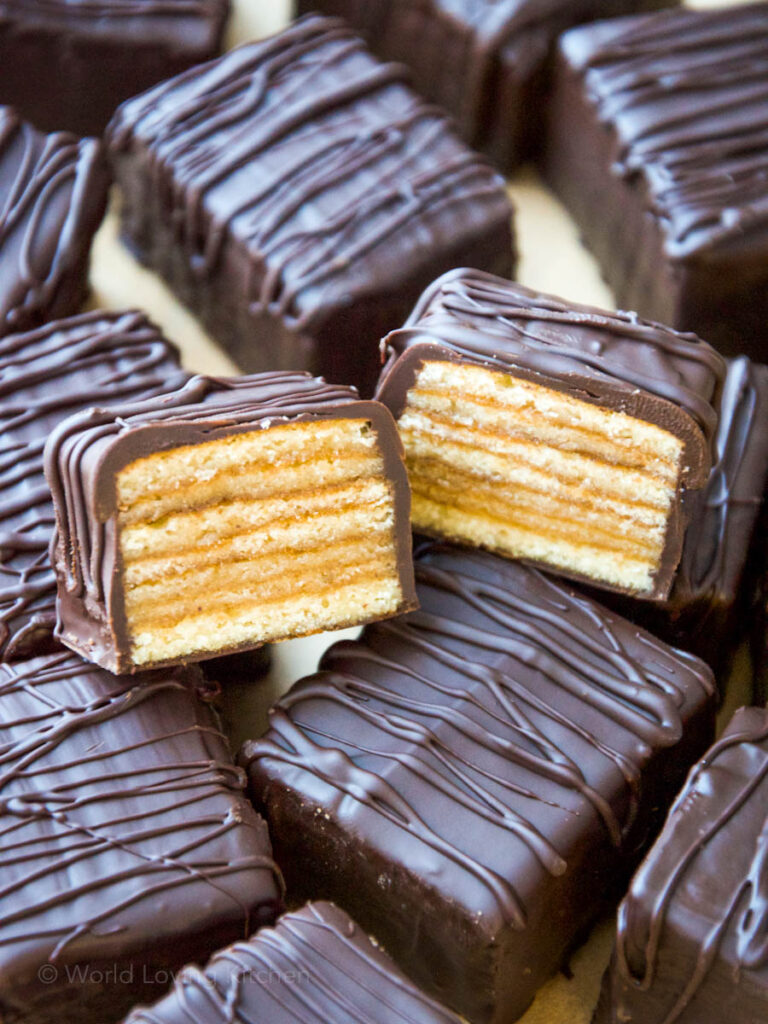
13. Baumkuchen
Baumkuchen is a unique German cake that looks like a tree trunk when sliced. Its name means “tree cake” in German.
This special dessert is made by baking thin layers of batter one at a time. Each layer is added and cooked under a broiler until golden brown.
The result is a cake with 10-20 delicate rings that resemble the growth rings of a tree. Baumkuchen has a rich, buttery flavor with hints of almond.
You’ll often find this cake covered in chocolate glaze. It’s a popular treat in German bakeries and cafes.
Making Baumkuchen at home can be tricky, but it’s possible with patience. The recipe uses ingredients like almond paste, butter, eggs, and rum.
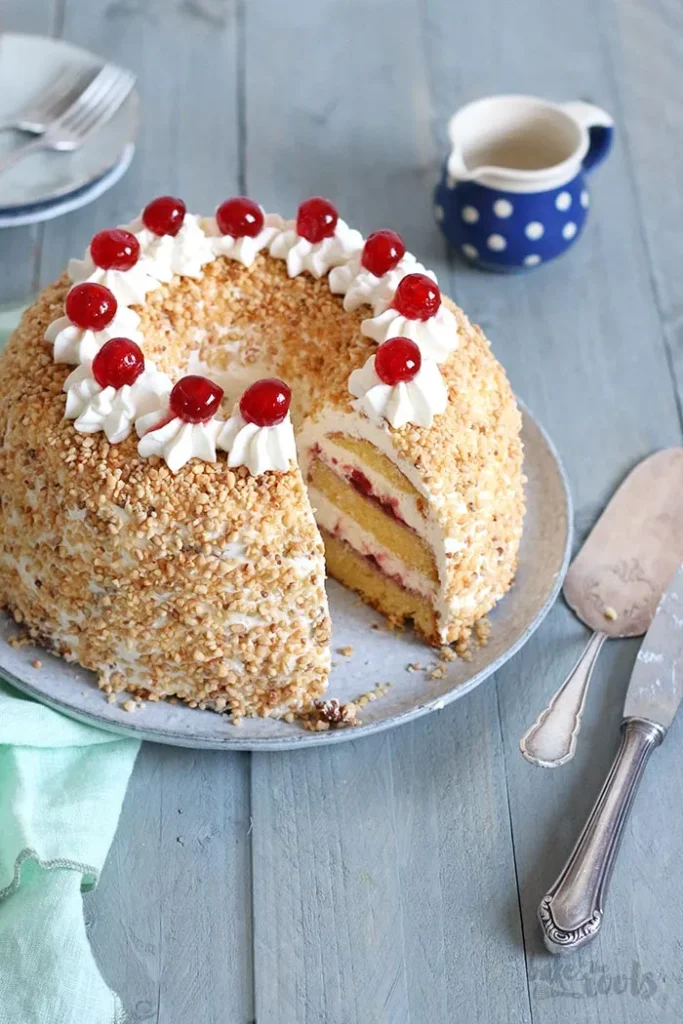
14. Frankfurter Kranz
Frankfurter Kranz is a classic German cake that looks like a crown. It’s made with a ring-shaped sponge cake that’s sliced into layers.
You fill the layers with buttercream and sometimes jam. The outside is covered with more buttercream and sprinkled with crunchy, caramelized nuts called krokant.
To make it, you bake the cake in a special pan. After cooling, you cut it into layers and add the fillings. The final touch is decorating the top with cherries.
This fancy cake is perfect for special events. It’s sweet, rich, and has a mix of soft and crunchy textures that you’ll love.
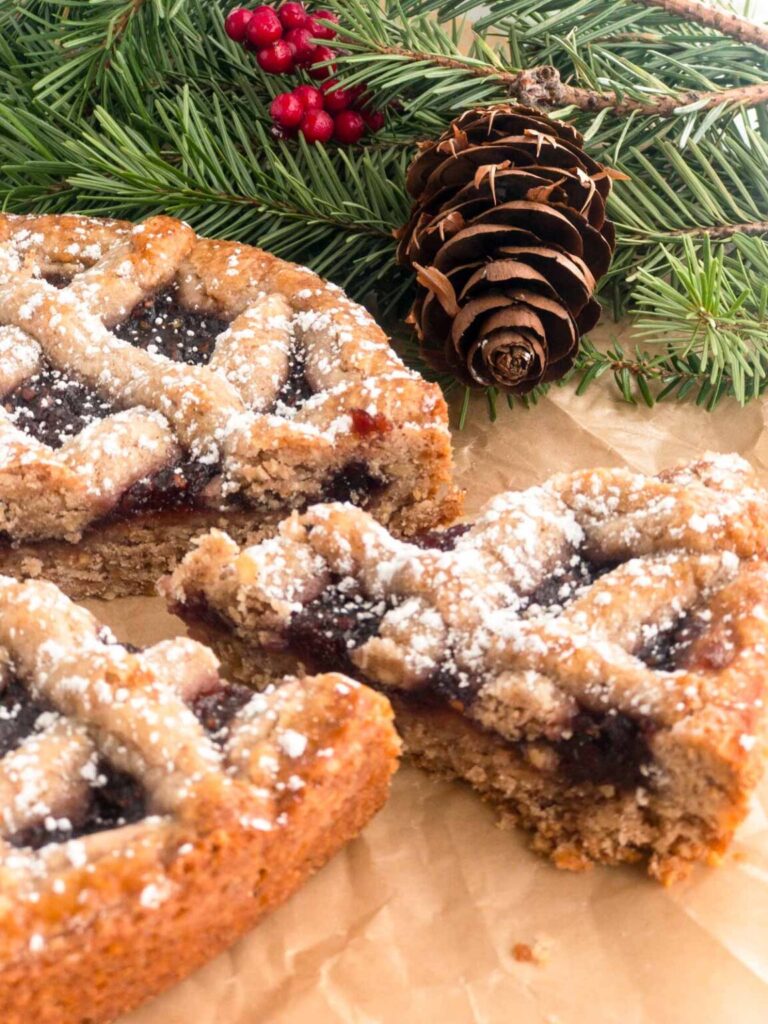
15. Linzer Torte
Linzer Torte is a classic German dessert that’s sure to impress. This sweet treat features a buttery crust made with ground nuts, usually hazelnuts or almonds.
You’ll find a layer of fruity jam spread between the crust and a lattice top. Raspberry jam is the traditional choice, but other flavors work well too.
To make Linzer Torte, you’ll mix butter, sugar, and eggs with flour and ground nuts. Chill the dough, then press most of it into a pan. Spread jam over the base and create a lattice pattern with the remaining dough on top.
Bake your Linzer Torte until golden brown. Let it cool before slicing.
This dessert pairs perfectly with coffee or tea for a cozy afternoon treat.
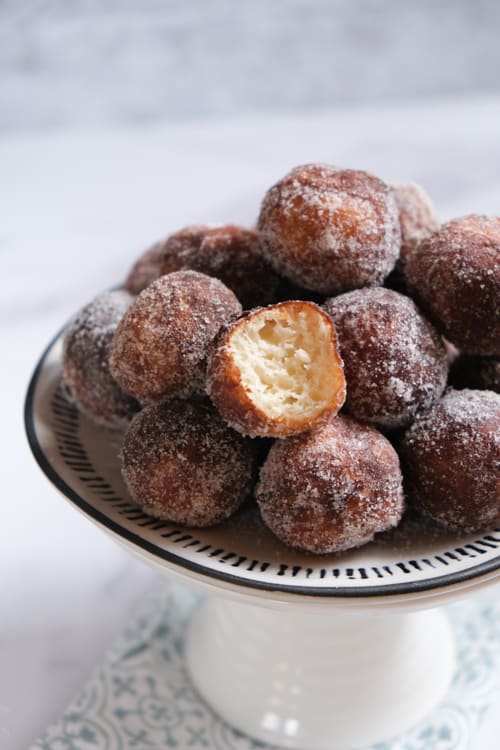
16. Quarkbällchen
Quarkbällchen are delightful German pastries that you’ll love. These small, round treats are made with quark, a creamy cheese popular in German baking.
To make Quarkbällchen, you mix quark with eggs, sugar, and flour. The dough is then formed into small balls and deep-fried until golden brown.
Once cooked, you roll these warm, fluffy balls in a mixture of sugar and cinnamon. This gives them a sweet, slightly crunchy coating.
You can enjoy Quarkbällchen as a snack or dessert. They’re often served at fairs, markets, and bakeries throughout Germany.
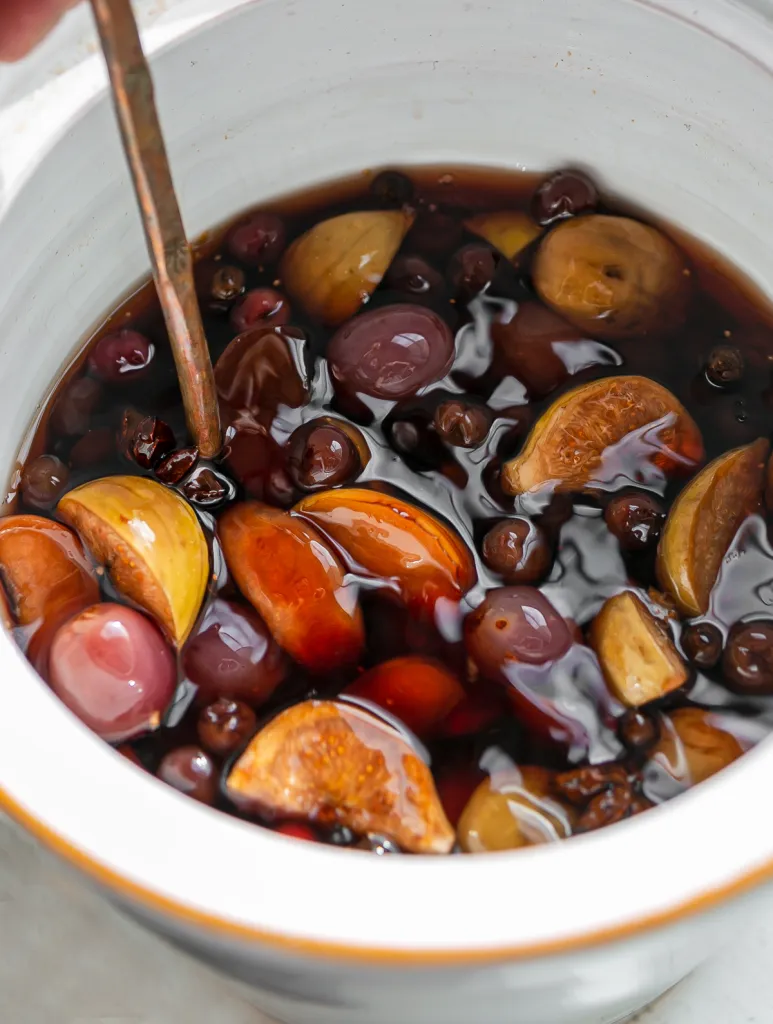
17. Rumtopf
Rumtopf is a German dessert that combines fruit and rum. You start making it in spring and add layers of seasonal fruits throughout the year.
To make Rumtopf, you need a large crock or container. Add ripe fruits and cover them with rum as you go. The mixture sits for months, allowing the flavors to blend.
By winter, your Rumtopf is ready to enjoy. You can serve the rum-soaked fruit over ice cream or cake.
It’s a sweet, boozy treat perfect for holiday gatherings.
Rumtopf is easy to make at home. You’ll need various fruits, sugar, and dark rum. Popular fruit choices include cherries, strawberries, and peaches.
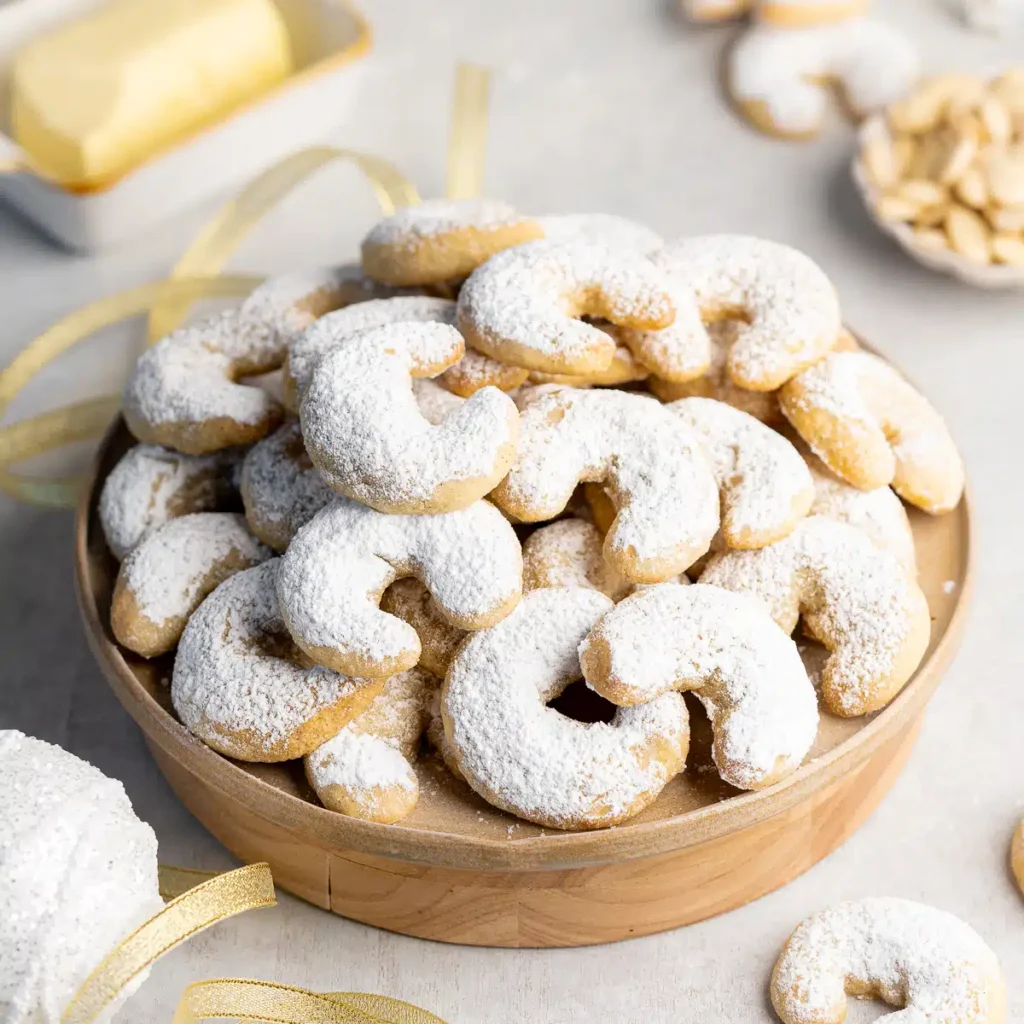
18. Vanillekipferl
Vanillekipferl are crescent-shaped cookies popular in Germany during Christmas. These delicate treats melt in your mouth with a buttery, nutty flavor and vanilla aroma.
To make Vanillekipferl, you’ll need flour, butter, powdered sugar, vanilla, and ground nuts – usually almonds or walnuts. Mix the ingredients into a dough and chill it for about an hour.
Shape the dough into small crescents and bake until lightly golden. While still warm, coat the cookies in vanilla-scented powdered sugar. This gives them their signature sweet, snowy appearance.
Vanillekipferl are perfect with a cup of coffee or tea. They make great homemade gifts too. Store them in an airtight container to keep them fresh for up to two weeks.
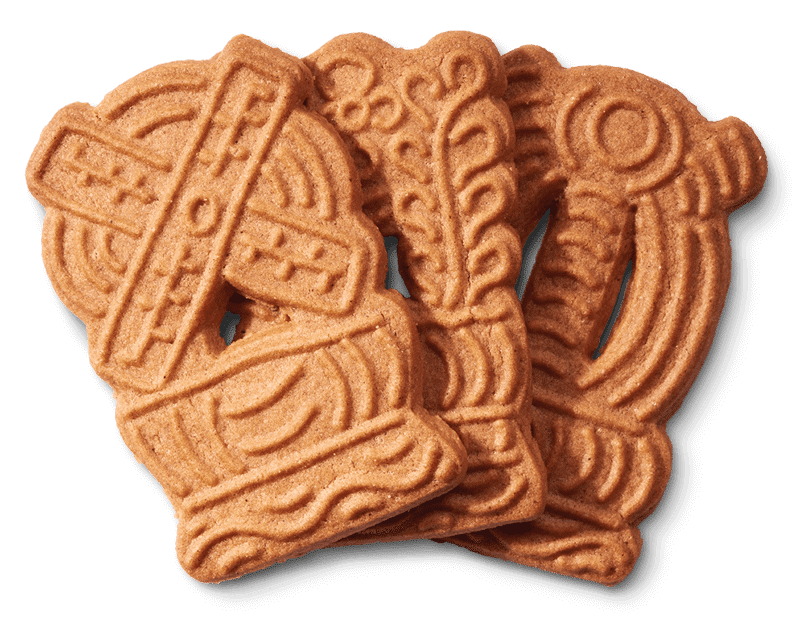
19. Spekulatius
Spekulatius are traditional German spiced cookies enjoyed during the holiday season. These crisp, thin cookies have a distinctive flavor from a blend of warm spices.
To make Spekulatius, you’ll mix flour, sugar, butter, and eggs with spices like cinnamon, cloves, and cardamom. The dough needs to chill for at least an hour before baking.
You can shape the cookies using special molds or cookie stamps to create intricate designs. Bake them until golden brown at 350°F for 10-12 minutes.
Spekulatius pair wonderfully with a cup of coffee or tea. Their crunchy texture and aromatic spices make them a beloved German Christmas treat.
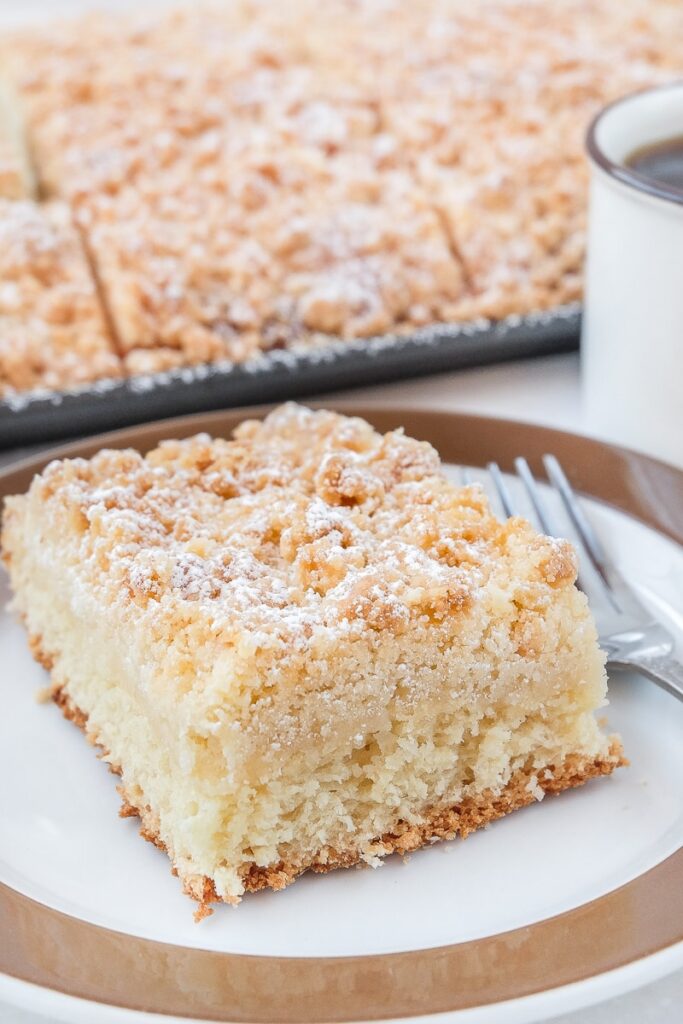
20. Streuselkuchen
Streuselkuchen is a classic German crumb cake you’ll love. It’s a simple yet delicious dessert with a yeast dough base and sweet, crumbly topping.
To make Streuselkuchen, you start by preparing a yeast dough. Let it rise while you make the streusel topping.
The topping is a mix of flour, sugar, and butter. You combine these ingredients until they form coarse crumbs.
Some recipes add a layer of fruit jam between the dough and streusel. Apple is a popular choice.
Bake the cake until golden brown. The result is a tender cake with a crisp, sweet topping that’s perfect with coffee or tea.
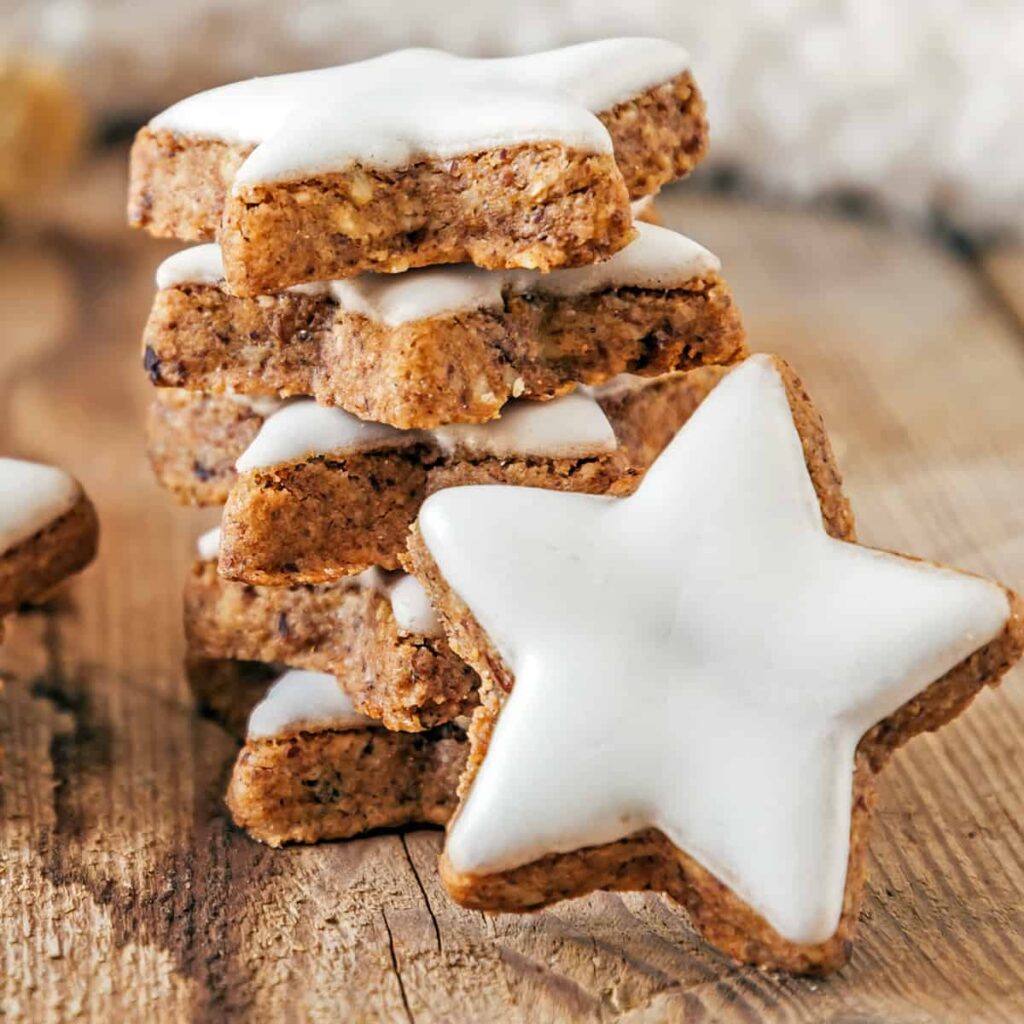
21. Zimtsterne
Zimtsterne are German cinnamon star cookies popular during Christmas. These treats are made with ground almonds, powdered sugar, and cinnamon.
To make Zimtsterne, you mix these ingredients with egg whites to form a dough. Roll out the dough and cut star shapes using a cookie cutter.
Before baking, you top the stars with a white icing made from egg whites and sugar. Bake them at a low temperature until they’re just set.
The result is a chewy, nutty cookie with a sweet cinnamon flavor and crisp meringue topping. Zimtsterne are a festive addition to any holiday cookie plate.
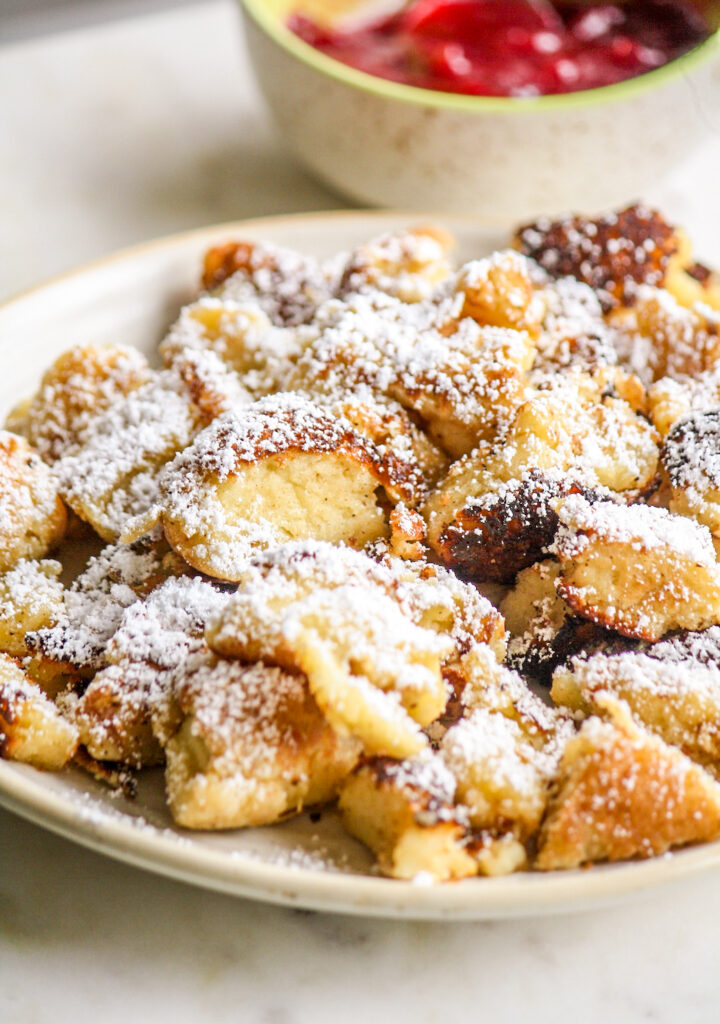
22. Kaiserschmarrn
Kaiserschmarrn is a beloved Austrian dessert that’s also popular in Germany. This sweet dish features torn or shredded pancakes.
To make Kaiserschmarrn, you’ll create a fluffy pancake batter with eggs, flour, milk, and sugar. Some recipes add rum-soaked raisins for extra flavor.
The pancake is cooked in a pan, then torn into bite-sized pieces while still cooking. This creates a mix of crispy and soft textures.
Once cooked, you’ll sprinkle powdered sugar over the pancake pieces. Kaiserschmarrn is often served with fruit compotes, jams, or applesauce on the side.
You can enjoy this versatile dish as a dessert or even as a hearty breakfast. It’s a tasty treat that’s sure to satisfy your sweet tooth.
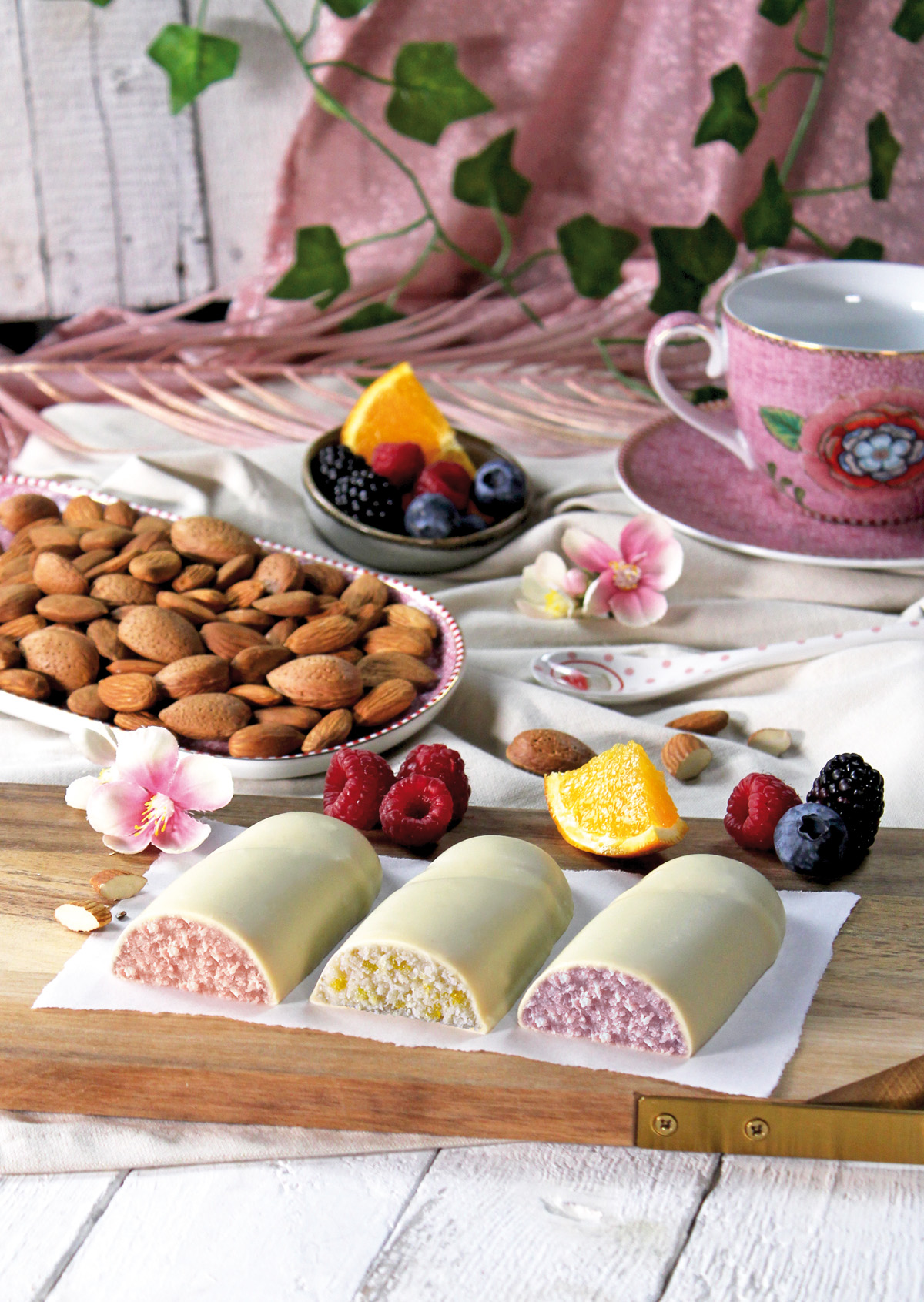
23. Marzipanbrot
Marzipanbrot is a delightful German Christmas treat that combines the flavors of marzipan and bread. This sweet confection looks like a miniature loaf of bread but is made entirely of marzipan.
To make Marzipanbrot, you’ll shape marzipan into small loaves and dust them with powdered sugar. Some recipes add cocoa powder to create a darker “crust” appearance.
You can find Marzipanbrot in German bakeries and Christmas markets during the holiday season. It’s often given as a gift or enjoyed as a festive snack with coffee or tea.
Try making Marzipanbrot at home for a taste of German Christmas tradition. It’s a simple yet impressive treat that captures the spirit of the season.
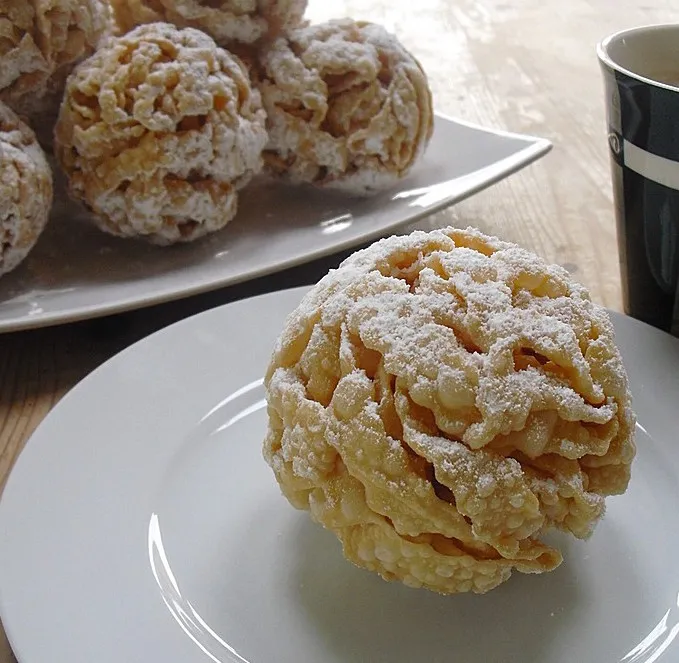
24. Schneeballen
Schneeballen are a unique German pastry from Rothenburg ob der Tauber. The name means “snowballs” in English, which describes their round shape.
These treats are made from strips of shortcrust pastry woven into a ball. They’re then deep-fried until golden and crispy.
Traditional Schneeballen are dusted with powdered sugar. You can also find versions covered in chocolate glaze or nuts.
These pastries have a satisfying crunch when you bite into them. They’re often enjoyed as a special treat or souvenir from Rothenburg.
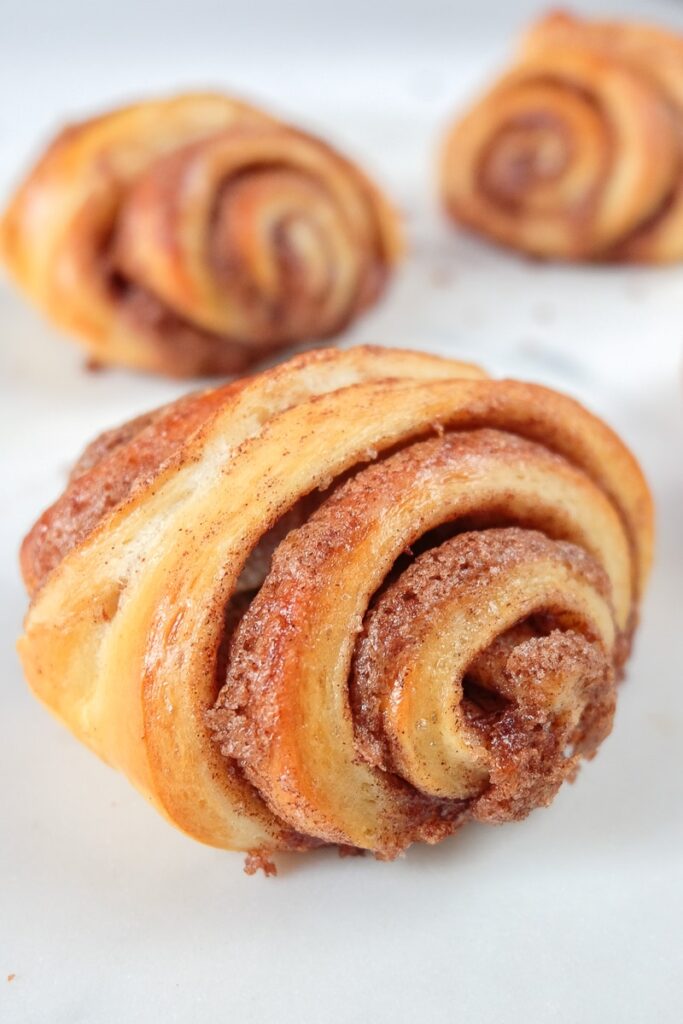
25. Franzbrötchen
Franzbrötchen are sweet pastries that originated in Hamburg, Germany. These treats combine elements of croissants and cinnamon rolls.
To make Franzbrötchen, you’ll need to create a yeast dough and let it rise. Then, roll out the dough into a rectangle and spread it with a mixture of butter, sugar, and cinnamon.
Next, roll the dough into a long sausage shape and cut it into sections. Press down on each section with a wooden spoon handle to create the signature shape.
Bake the Franzbrötchen until they’re golden brown and flaky. The bottom will caramelize, adding a delicious crunch.
These pastries are perfect for breakfast or as an afternoon snack with coffee. You can find them in bakeries throughout Hamburg and northern Germany.
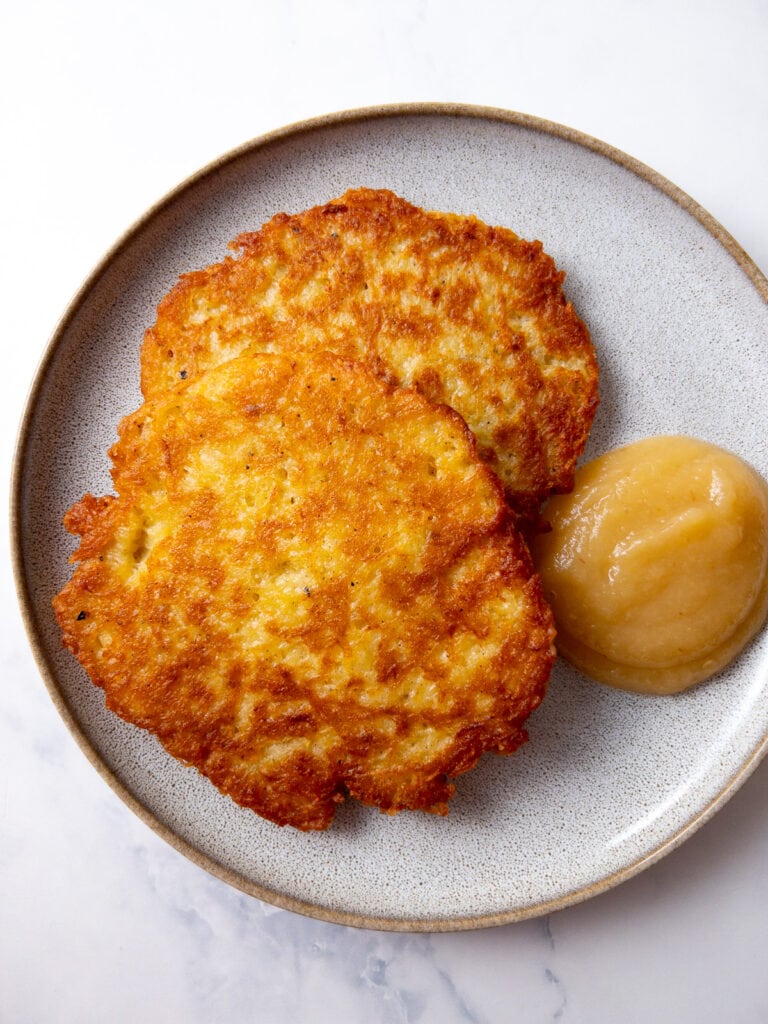
26. Kartoffelpuffer
Kartoffelpuffer are crispy German potato pancakes. You’ll love these golden-brown treats made from grated potatoes, onions, eggs, and flour. They’re fried until crispy on the outside and tender inside.
You can enjoy Kartoffelpuffer as a sweet or savory dish. For a classic sweet version, serve them with applesauce and a sprinkle of sugar. If you prefer savory, try them with sour cream or smoked salmon.
These pancakes are popular street food in Germany. You’ll often find them at festivals and Christmas markets. They’re easy to make at home too. Grate starchy potatoes, mix with the other ingredients, and fry in hot oil until crispy.
History of German Desserts
German desserts have a rich heritage spanning centuries. They reflect regional traditions, seasonal ingredients, and cultural influences from neighboring countries.
Traditional Ingredients
German desserts often use local ingredients. Apples, cherries, and plums are popular fruits in many recipes. Nuts like almonds and hazelnuts add crunch and flavor. Dairy products play a big role too. Quark, a fresh cheese, is used in cheesecakes and pastries. Butter and cream enrich many treats.
Chocolate became a key ingredient in the 19th century. It’s now essential in famous desserts like Black Forest Cake. Spices like cinnamon and cardamom add warmth to holiday sweets. Honey has been used as a sweetener since ancient times.
Regional Variations
Each German region has its own dessert specialties. In the north, you’ll find fruit-based treats like Rote Grütze, a red berry pudding. The Black Forest area is known for its cherry-filled cakes.
Bavaria is famous for its apple strudel and cream puffs. Berliners, jelly-filled doughnuts, are a specialty of the capital. The Rhine region makes Dampfnudel, sweet yeast dumplings.
Some desserts have religious roots. Stollen, a fruit-filled bread, is tied to Christmas traditions. Easter brings chocolate bunnies and egg-shaped treats to tables across Germany.
Cultural Significance
German desserts play a big role in the country’s food culture. They show up at special events and have shaped sweet treats in other places too.
Festive Occasions
German desserts are key parts of many holidays and events. At Christmas, you’ll find stollen and lebkuchen on tables across Germany. These sweet breads and cookies are must-haves for the season. Easter brings its own treats like bunny-shaped cakes.
Birthdays often feature tortes with fancy decorations. Weddings might have a tall tree made of cream puffs called a krokant. Even regular Sundays are special with coffee and cake in the afternoon.
Influences on Modern Cuisine
German desserts have spread far beyond the country’s borders. You can find Black Forest cake in bakeries around the world.
Apple strudel is popular in many places, not just Germany and Austria.
German baking methods have also had a big impact. The idea of using yeast in sweet breads has caught on in other countries.
German-style bakeries can be found in many cities globally. They offer pretzels, strudels, and other treats that remind people of Germany.
Some German desserts have been updated for modern tastes. Chefs now make lighter versions of rich cakes.
They also use local fruits in traditional recipes to give them a fresh twist.
